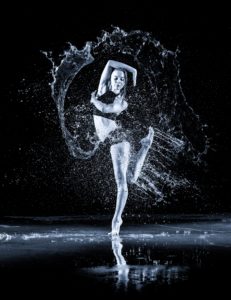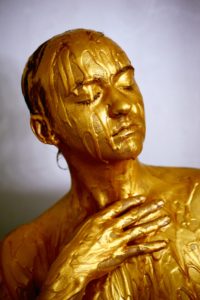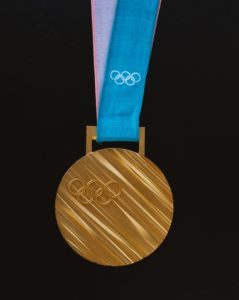February was unexpectedly cold in Seattle; snowflakes swirled above the agitated surfaces of the lakes. I tried to find order in their movement while I watched them through the windows of the co-working space where I come to write. When the winds paused, the snowfall paused as well, and the surface of Lake Union coated with silver. The placid lake looked just like the Olympic Ice Rink in South Korea, quiet and ready for the showdown between artistry and performance.
The whole month of February, I entertained myself playing my favorite guessing games: who will win Olympic medals in Figure Skating and who will win the Academy Award for the best original screenplay. After seeing all the openings, turns, spins, twizzles, jumps, loops, step sequences, flips, twists, and pulls, it came to my mind to draw connections between figure skating and storytelling.
Five stories are in the running for the best original screenplay (the storytellers performed in singles and pairs): Get Out, written by Jordan Peele, Lady Bird, written by Greta Gerwig, Three Billboards Outside Ebbing, Missouri, written by Martin McDonagh, The Shape of Water, screenplay by Guillermo del Toro and Vanessa Taylor, story by Guillermo del Toro, and The Big Sick written by Emili V. Gordon and Kumail Nanjiani. The order I chose to list them on the page corresponds to their placement on my imaginary medal panel. And that medal panel resembles the one in Ladies’ Figure Skating Final at the 2018 Winter Olympics in Pyeongchang.
Everyone who watched Figure Skating last month knows about the rivalry between the two contestants from Russia, Alina Zagitova and Evgenia Medvedeva. I didn’t have a chance to watch the latest European Tournament where Zagitova (still the reigning World Junior Champion) debuted, so I first saw her skate a couple of weeks ago at the Team Event where she blew my mind with her Free Program. She is fifteen years old, beautiful as a swan, and she has the confidence of a Spartan soldier. Her Free Program was choreographed to deliver the highest possible technical score in Gangneung Ice Arena, so it was only the matter of whether she was going to give her best performance. Her teammate and her only rival, Evgenia Medvedeva, came to Pyeongchang as a favorite for gold and probably wanted the medal a bit more or if not, then certainly for three years longer than Zagitova. Medvedeva showed breathtaking artistry, sophisticated appeal on the ice, and one jump differently placed (and one point less valued) in her Free Skate. Neither of these girls feared possible mistakes, their minds were assured and calm, their legs strong, their eyes set on the prize. To win, Medvedeva had to defeat Zagitova by a fraction of a point, and Zagitova only had to be her best self.
Greta Gerwig’s Lady Bird is a smart and tasteful coming-of-age story about an imaginative girl from Sacramento, California, who in her senior year of high school rebels against the fears of her mother and the conformities of her class and society and dares to dream bigger than her parents ever did, hoping to fly away from their nest in pursuit of her happiness. Does this summary sound like the most original story you have ever heard of? Of course not. All coming-of-age stories are more or less like one another. Those who enjoy watching or reading this genre know what they are going to get. It is similar to watching someone’s Free Skate – before a skater sets their blades on the ice, the spectators are aware of the possible elements.
Our ideal coming-of-age hero is a teenager who is different from the crowd and has significant or even impossible dreams (for instance winning the Olympic gold at the age of fifteen by beating the world’s best). We want some external forces pulling the teenager away from the prize (always pays off if the writer throws in conservative parents), and we expect the right amount of the internal conflict. Also, we crave for sensual elements. Good for us, our hero is done being a virgin and can’t wait to experience the corporeal changes.
So, if we already know the elements the writer of the coming-of-age story is going to use, and we sort of know the story ending – our hero will grow up, how can we tell if one story is better than the other? Well, like in Figure Skating, it is all about the grade of execution of the given elements. This year, Greta Gerwig created a lovable, relatable, and complex character, and she was able to interpret and perform the familiar coming-of-age elements gorgeously. Lady Bird’s biggest strength is the flawless composition of the story, and Greta Gerwig is a deserving contender for Oscar’s gold. Although Gerwig’s story is not groundbreaking or breathtakingly original, Lady Bird is still a beautiful, universal and relevant film, entirely worthy of attention.
On my imaginary board, I compare Lady Bird to Evgenia Medvedeva and her silver medal for which she delivered the most compelling performance of the 2018 Winter Olympics. She did lose the battle in which she had given all she possibly could and probably returned home inconsolable. Her younger teammate and rival Alina Zagitova took the gold because she was gutsier to commit to a slightly more difficult program. The backloading of her Free Skate – the placement of all her crucial jumps in the second half of the program, made her performance more thrilling.
What Lady Bird lacked is what Jordan Peele successfully delivered in his screenplay Get Out. The thrill. Get Out is a psychological thriller (I don’t agree with its categorization as a horror movie). Therefore, the story had to be exciting throughout. Yes, Lady Bird is a dramedy, and nobody expected it to be suspenseful, but it could have been more dramatic. Not for a single moment of the movie did I worry for the wellbeing of the heroine. And my husband who was sitting next to me in the cinema was noticeably bored by the movie’s slow movement.
In Get Out, Jordan Peele took many risks. First, he envisioned a fresh take on the genre and pushed a solid thriller story into the realm of art (if this were a novel it would have been an edgy literary thriller and a contender for the National Book Award), then he enhanced an already excellent story with elements of satire, and finally, he leaped into the thought-provoking analysis of his time and society. Many people with whom I discussed this movie thought that the racial aspects of the story were exaggerated, some even brought up how the story was all and only about the race. I don’t agree. The job of the satire is to be loud and bold and even dire, which is precisely what Peele did. Satirical stories, unlike coming-of-age accounts, are not for everyone. Jordan Peele’s Oscar success is depending on the subjective decision of the Academy.
I enjoyed both movies, and I would be happy to see both Gerwig and Peele on the podium. But to pencil down my Oscar guess, I had to perform a little experiment. This time, I compared the stories to other two figure Skating Performances – Nathan Chen’s and Adam Rippon’s. Both skaters represented the United States of America in Pyeongchang and competed and won bronze medals in the Team Event. Eighteen-years-old Nathan Chen, also known as the Quad King, came to the Olympics as one of the top contenders for the gold medal in Men’s Singles. Twenty-eight-year-old Adam Rippon whose program didn’t have impressive technical elements had to be more creative in his routine to validate his place on the national team. When Nathan Chen messed up his short program by falling and failing in executing his signature element, all the hopes were on Rippon whose audacious and elegant presence on ice won the hearts of the audience. And moreover, Rippon, who dares say his mind and stand up for what he believes, challenged many including vice president Pence.
The Quad King’s act without the quads was not worthy of a medal. Rippon, on the other hand, aware of the technical advantage of his opponents, had to bring excitement and attitude to his program. In the end, he did go home with a medal and became fan’s and social media favorite and the memorable voice of the 2018 Winter Olympics.
If we took away the name “Lady Bird” from the protagonist and the movie, the alternate story would remain unfinished, and we wouldn’t be able to distinguish Gerwig’s coming-of-age from other representatives of the genre. However, if we took away the racial aspect of Get Out, the alternate story would still be extraordinary, only less political. The job of a satirical movie is to portray the time and culture from which it originates, and the role of an Oscar-winning writer is to be loud and daring, to push themselves beyond their limits. Jordan Peele has done it all.
The bronze medal in Ladies’ Singles went to Canada with Kaetlyn Osmond. From the beginning, Osmond knew that she was only in the mix for the bronze and that, to take the medal, she had to set her new personal bests and ignore the superiority of the Russians. Freeing herself from the expectations of the impossible, she skated for herself, and not only did she secure the third place, but she beat the others by several points creating a significant gap between the podium and the fourth place.
Let me compare Three Billboards Outside Ebbing, Missouri, already awarded with the Golden Globe for writing, to Osmond’s performance. The story is well told; the characters are engaging; the overall voice is singular enough to charm the audience. However, Martin McDonagh’s execution of technical elements isn’t that superlative to make him a contender for silver or gold.
Three Billboards Outside Ebbing, Missouri portrays too many characters who are, in their essence, very similar and none of them change by the end of the movie. They are all unrealistically funny for some small-town inhabitants, and all of them together make a cast of characters that should have belonged to a different setting. It is more a mockery than a satire. And I don’t appreciate mockery. Also, this story severely lacks empathy. It opens with a harsh bite of reality: The majority of the rape cases in the United States don’t ever get solved; too often there is no justice for the raped and murdered girls and women. This premise promised a soulful and heartbreaking story of a family who survived such tragedy, but, in the end, all we got were jaws sore from laughing.
As the story continued, too many themes stirred in the pot, because of which the writer lost focus and forgot his beginning promise. The second most important theme that McDonagh successfully threaded throughout was the (in)human craving for violence. What concerned me was McDonagh’s decision to repeat a few times out loud that violence created more violence. Trust your audience, Mr. McDonagh, we are smart people, we would have figured this out ourselves.
Stories that came in fourth and fifth place on my imaginary panel are The Shape of Water and The Big Sick. However, the noticeable difference in the total score between the movies that made to my podium and the fourth and fifth place created a significant gap.
If the figure skating judging panel evaluated the stories, Guillermo del Toro and Vanessa Taylor would have lost major points for their poor technical elements, then assured the high placement because of their superb artistry and creative interpretation of the given story.
The foundation of The Shape of Water is full of holes. It is not much more but a retelling of The Beauty and the Beast with elements borrowed from different tales from all around the globe mixed with stereotypical representations of the secondary characters. In the end, the characters don’t grow or change (they mostly end up dead), and the story doesn’t prove anything else but the fact that a storyteller who earns the industry’s respect can abuse their privilege to make bizarre movies about “incomplete” women and their unlikely monster fantasies. What is memorable about this movie is not the story but its execution. If one closes one’s eyes and ears to all the insults that the tale itself throws upon a viewer, one could find The Shape of Water lovely and worth watching. The cinematography, the music, the acting… all these elements are the proof of del Toro’s resourcefulness and his authentic point of view. I don’t mind his nomination for the best director at all; I just can’t get along with the nomination for the best original screenplay.
The Big Sick was another intruder in the category. It is a solid movie. A romantic comedy based on the writers’ real-life love story. All good love stories borrow from the real life, so I didn’t mind learning about Gordon’s and Nanjani’s relationship. However, the problem of The Big Sick is its mediocre quality. The writers, who are also the characters in the story, couldn’t detach themselves enough from their on-screen baby to see which parts of their script needed more work. The best stories are bigger than life. This one is just fine. I love romantic comedies, and I’ve seen a high number of them, so I can tell with confidence if the one I just watched could become the one that would be watched over and over again.
I apply the same rule to the contenders of Ice Dance. I like replaying the winning performances, and the performances that brought me delight because I know that when I see them again, I know that whenever I see Virtue and Moir or Papadakis and Cizeron again, I will rejoice. A romantic comedy deserving of an Oscar nomination needs to be on my list of the movies I will want to see dozens of times. I don’t have a strong enough reason to watch The Big Sick again. Kumail and Emili gave their hearts to the project, and for that I applaud them. Nevertheless, their dance wasn’t exciting.
I don’t seem to have a favorite story this year. But I am glad that the skater I most cheered for won her gold medal at what appears to be her last Olympics. At the age of thirty-four, Aljona Savchenko with her new partner Bruno Massot set a pairs’ Free Program world record and won her first and so well deserved Olympic gold. My heart was full of joy and admiration for her. The majestic Free Skate of the German pair was the best possible ending to Savchenko’s fruitful athletic career.
The best stories end with a blast, then echo for a long, long time. Unfortunately, this was the element I didn’t find in any of the movies competing in the best original screenplay category of the 9oth annual Academy Awards. In my February showdown, figure skaters won with fireworks. My fellow storytellers need to sharpen their blades and improve their jumps.




